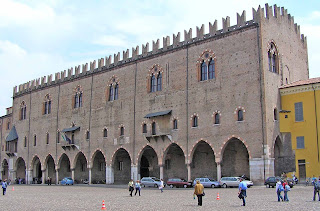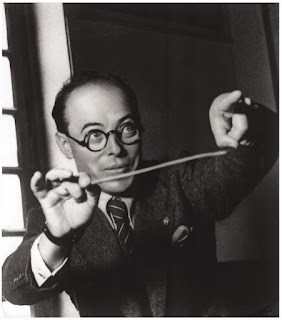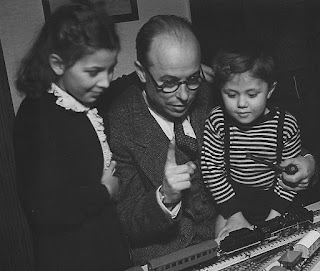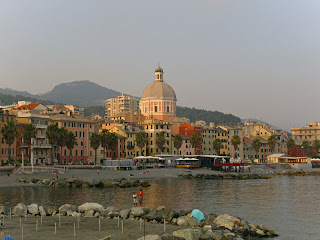Life’s work put him among greats of commedia all’italiana
 |
Mario Monicelli directed his first film in 1949, which also
marked the start of his successful relationship with Totò |
Mario Monicelli, the director who became known as ‘the father of commedia all’italiana’ and was nominated for an Oscar six times, was born on this day in 1915 in Viareggio.
He made more than 70 films, working into his 90s. He helped advance the careers of actors such as
Vittorio Gassman, Marcello Mastroianni and
Claudia Cardinale, and forged successful associations with the great comic actors Totò and Alberto Sordi.
Commedia all’italiana was notable for combining the traditional elements of comedy with social commentary, often addressing some of the most controversial issues of the times and making fun of any organisation, the Catholic Church in particular, perceived to have an earnest sense of self-importance.
The genre’s stories were often heavily laced with sadness and Monicelli’s work won praise for his particular sensitivity to the miseries and joys of Italian life and the foibles of ordinary Italians. He claimed the lack of a happy ending actually defined Italian humour and that themes drawn from poverty, hunger, misery, old age, sickness, and death were the ones that most appealed to the Italian love of tragi-comedy.
 |
Monicelli continued to direct films
into his 90s |
He was part of a golden generation of Italian directors including
Luchino Visconti, Pier Paolo Pasolini, Bernardo Bertolucci, Dino Risi and
Luigi Comencini, and many of his films were hailed as masterpieces, including the caper comedy
I soliti ignoti (1958), which was packaged for American audiences as
Big Deal on Madonna Street, the satire
La grande guerra (The Great War, 1959), which won him Venice's Golden Lion award, and the bitter-sweet drama
I compagni (The Comrades, 1963), also known as The Organizer.
Monicelli was the son of a noted journalist,
Tommaso Monicelli, and had two older brothers, one a writer and translator, the other a journalist. He attended the universities of Pisa and Milan, where he studied literature and philosophy, and after graduation became became a film critic and amateur film-maker. At the age of just 20 he made a feature-length film,
I ragazzi della via Paal, which won an amateur prize at the Venice Film Festival in 1935.
He spent 12 years as scriptwriter and assistant director, collaborating on some of the most celebrated Italian films of the 1940s, including
Giuseppe De Santis’s Riso Amaro (Bitter Rice, 1949).
Monicelli’s debut as a director came in a collaboration with
Steno (real name Stefanio Vanzina) on
Totò cerca casa (Totò looks for a house, 1949), the first of several popular films the pair made starring Totò over the next four years, including
Guardie e Ladri (Cops and Robbers, 1951) and
Totò e i Re di Roma (1952).
Totò cerca casa was typical of the genre, a farce set against the background of Italy’s desperate housing shortage.
Guardie e Ladri caused controversy because it was about the friendship between a thief and a policeman, two men from similar backgrounds sharing similar problems, a concept considered so revolutionary that Monicelli had to appear personally before the sensors before it could be released.
 |
Alberto Sordi (left) and Vittorio Gassman in a scene
from the tragic Italian movie La grande guerra |
Totò e Carolina (1955), which depicted a young suicidal girl being helped by Communists, was actually banned for a year and a half, and was ultimately granted a certificate only after Monicelli had made 34 cuts.
I soliti ignoti, sometimes called Italian cinema's first true Commedia all'Italiana film, was his first hit. Starring Totò, it gave early comedy roles to Mastroianni, Gassman and Cardinale. Despite the lack of a happy ending, it was a success both in the United Kingdom, where it was titled
Persons Unknown, and in the US, where it was also turned into a Broadway musical.
Next came Monicelli’s bravest and possibly most controversial film, the funny but poignant
La grande guerra, a scathing satire of the First World War with Sordi and Gassman as peasants thrust into the bewildering world of battle, which opponents claimed would defile the memory of the 600,000 Italians who died in the conflict but once released was seen as a triumph, a film that at last dared to say that so many men, poor men who were badly dressed, badly fed, ignorant and illiterate, had gone to fight a war that had little to do with them and was ultimately pointless. The film won the Golden Lion award at Venice, and, like
I soliti ignoti, was nominated for an Oscar as best foreign film.
 |
Totò (left) and Aldo Fabrizi in a scene from Guardie
e Ladri. They worked together in numerous films. |
I Compagni brought his second Oscar nomination and in 1968 came a third, for
La Ragazza con la pistola (Girl with the Gun), which starred Monica Vitti as a girl who travels from Sicily to London intending to murder her unfaithful lover.
Amici miei (My Dear Friends, 1975), a tale of ageing friends who play jokes on one another to camouflage the realities of disillusionment, loneliness and failure, proved one of his greatest hits, breaking records in Italy and France. The following year he won his final Oscar nomination, for another Mastroianni hit,
Casanova '70.
His last feature film was
Le rose del deserto (Rose of the Desert, 2006), the story of a group of soldiers in Libya during the Second World War, which he directed at the age of 91. Yet he had still not finished working, in 2008 directing a documentary entitled
Monti, about his adopted neighbourhood in Rome.
A lifetime supporter of left-wing parties, he remained politically active until late in life, in 2009 calling on students to protest against the government's proposals to cut the culture budget. He described Italy's then prime minister
Silvio Berlusconi as “a philistine” and "a modern tyrant".
Monicelli’s father, Tommaso, had committed suicide and when he was diagnosed with terminal prostate cancer in 2010, he decided he would end his life the same way, dramatically jumping from a window on the fifth floor of the
San Giovanni Addolorata Hospital in Rome.
Italy's President
Giorgio Napolitano said Monicelli would be "remembered by millions of Italians for the way he moved them, for how he made them laugh, and reflect."
 |
| Viareggio's Grand Hotel is a throwback to its heydey |
Travel tip:
Viareggio, the seaside resort in Tuscany in which Monicelli was born, has an air of faded grandeur, its seafront notable for the Art Nouveau architecture that reminds visitors of the town's heyday in the 1920s and '30s. Thanks to its wide, sandy beaches, however, the resort remains hugely popular, especially with Italians. In addition, it boasts a colourful Carnevale, featuring a wonderful parade of elaborate and often outrageous floats, that is second only to the Venice carnival among Italy’s Mardi Gras celebrations.
 |
| Via dei Serpenti, looking towards the Colosseum |
Travel tip:
One of Rome's oldest and most charming residential neighbourhoods,
Monti retains a bohemian flavour with chic cafes and street food and alternative fashion shops. Occupying the area between the Quirinal Hill and the Colosseum, in Roman times the area was home to craftsmen but also to prostitutes and good-for-nothings and was hidden from the more refined areas of the city by a large wall. Nowadays, it is popular with architects, screenwriters and other creative types as one of Rome’s most fashionable central areas. Monicelli’s former home in Via dei Serpenti is marked with a plaque.
Also on this day:
1945: The birth of business tycoon and former Inter chairman Massimo Moratti
1974: The birth of top-selling singer-songwriter Laura Pausini
Home
















